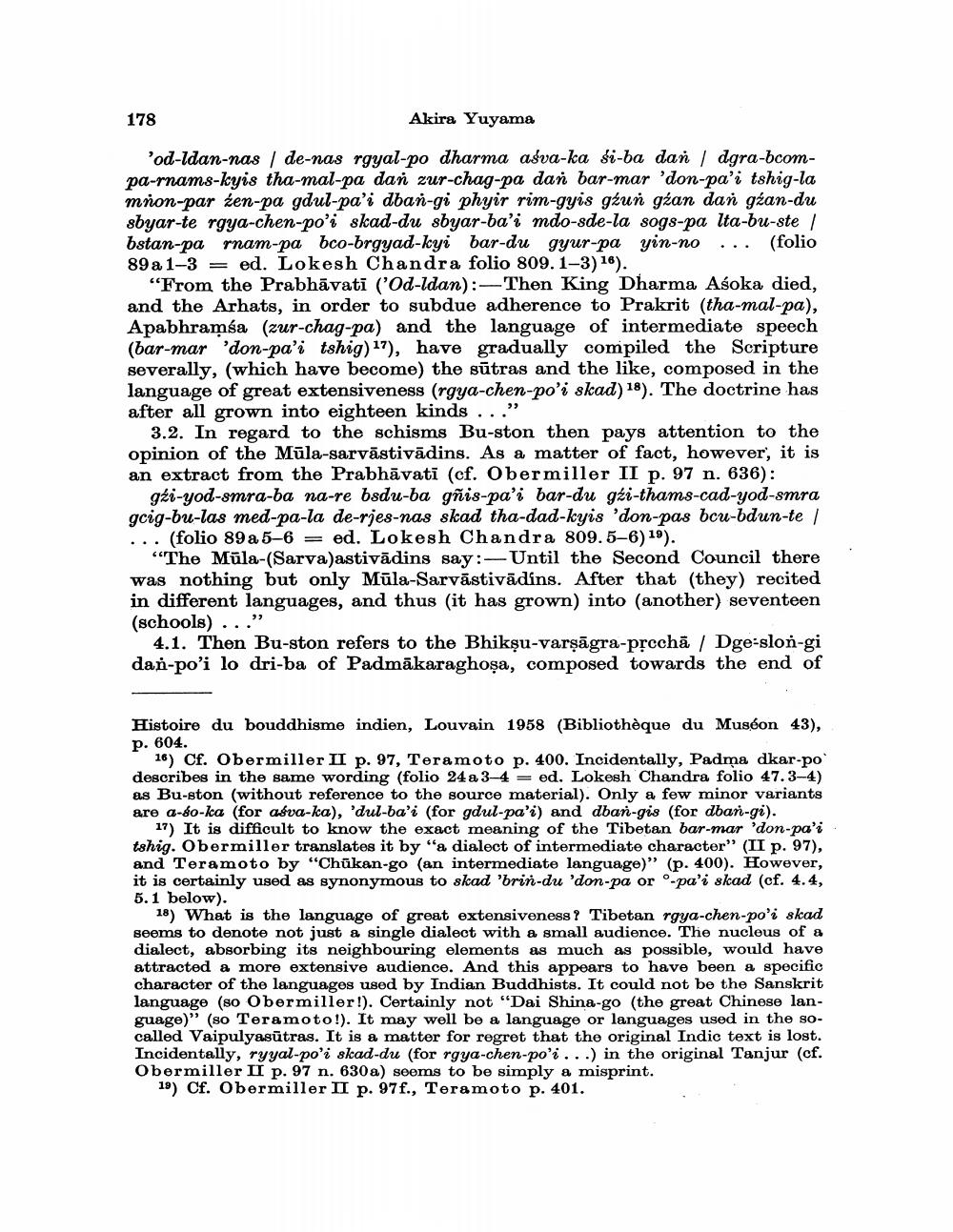Book Title: Buston On Languages Used By Indian Buddhists At Schismatic Period Author(s): Akira Yuyama Publisher: Akira Yuyama View full book textPage 4
________________ Akira Yuyama 'od-Idan-nas/ de-nas rgyal-po dharma abva-ka si-ba dań dgra-bcompa-rnams-kyis tha-mal-pa dań zur-chag-pa dań bar-mar 'don-pa'i tahig-la mnon-par źen-pa gdul-pa'i dban-gi phyir rim-gyis gun gran dan gian-du sbyar-te rgya-chen-po'i skad-du sbyar-ba's mdo-sde-la sogs-pa lta-bu-ste / bstan-pa rnam-pa bco-brgyad-kyi bar-du gyur-pa yin-no... (folio 89 a 1-3 = ed. Lokesh Chandra folio 809. 1-3) 16). 178 "From the Prabhavati ('Od-ldan):-Then King Dharma Aśoka died, and the Arhats, in order to subdue adherence to Prakrit (tha-mal-pa), Apabhraméa (zur-chag-pa) and the language of intermediate speech (bar-mar 'don-pa'i tshig) 17), have gradually compiled the Scripture. severally, (which have become) the sutras and the like, composed in the language of great extensiveness (rgya-chen-po'i skad) 18). The doctrine has after all grown into eighteen kinds..." 3.2. In regard to the schisms Bu-ston then pays attention to the opinion of the Mula-sarvāstivādins. As a matter of fact, however, it is an extract from the Prabhavati (cf. Obermiller II p. 97 n. 636): gźi-yod-smra-ba na-re badu-ba gñis-pa'i bar-du gti-thams-cad-yod-emra goig-bu-las med-pa-la de-rjes-nas skad tha-dad-kyis 'don-pas beu-bdun-te / ... (folio 89a5-6 ed. Lokesh Chandra 809.5-6) 19). = "The Mula-(Sarva)astivādins say:-Until the Second Council there was nothing but only Müla-Sarvāstivādins. After that (they) recited in different languages, and thus (it has grown) into (another) seventeen (schools)..." 4.1. Then Bu-ston refers to the Bhiksu-varṣagra-precha / Dge-slon-gi dan-po'i lo dri-ba of Padmakaraghosa, composed towards the end of Histoire du bouddhisme indien, Louvain 1958 (Bibliothèque du Muséon 43), p. 604. 16) Cf. Obermiller II p. 97, Teramoto p. 400. Incidentally, Padma dkar-po describes in the same wording (folio 24 a 3-4 ed. Lokesh Chandra folio 47.3-4) as Bu-ston (without reference to the source material). Only a few minor variants are a-so-ka (for aśva-ka), 'dul-ba'i (for gdul-pa'i) and dban-gis (for dban-gi). 17) It is difficult to know the exact meaning of the Tibetan bar-mar 'don-pa'i tshig. Obermiller translates it by "a dialect of intermediate character" (II p. 97), and Teramoto by "Chukan-go (an intermediate language)" (p. 400). However, it is certainly used as synonymous to skad 'brin-du 'don-pa or -pa'i skad (cf. 4.4, 5.1 below). 18) What is the language of great extensiveness? Tibetan rgya-chen-po'i skad seems to denote not just a single dialect with a small audience. The nucleus of a dialect, absorbing its neighbouring elements as much as possible, would have attracted a more extensive audience. And this appears to have been a specific character of the languages used by Indian Buddhists. It could not be the Sanskrit language (so Obermiller!). Certainly not "Dai Shina-go (the great Chinese language)" (so Teramoto!). It may well be a language or languages used in the socalled Vaipulyasutras. It is a matter for regret that the original Indic text is lost. Incidentally, ryyal-po'i skad-du (for rgya-chen-po'i...) in the original Tanjur (cf. Obermiller II p. 97 n. 630a) seems to be simply a misprint. 19) Cf. Obermiller II p. 97f., Teramoto p. 401.Page Navigation
1 2 3 4 5 6 7
